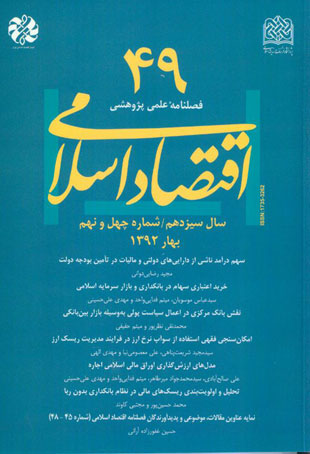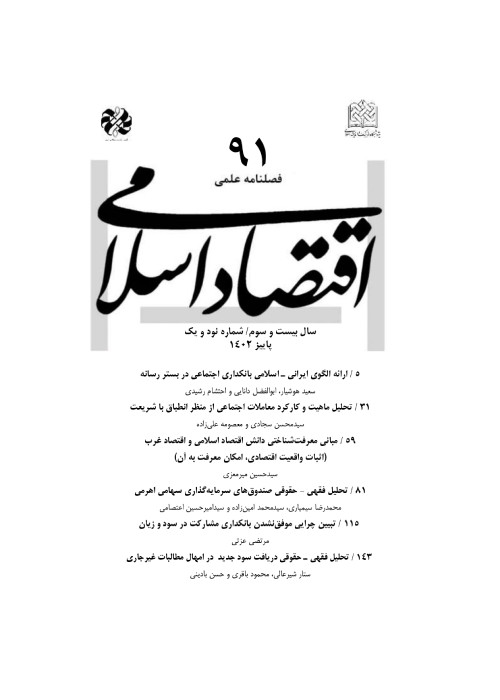فهرست مطالب

فصلنامه اقتصاد اسلامی
پیاپی 49 (بهار 1392)
- تاریخ انتشار: 1392/02/10
- تعداد عناوین: 7
-
-
Page 5Public expenses financing is one of the fundamental problems of all governments. In the sphere of economic theory, it has been proposed to finance all government expenses, including the current ones, by taxation. In the framework of Islamic economics as well, some scholars have proposed the same theory with regard to the Islamic government or to the government in Iran. As, according to the economic theorists, the government has little assets and most natural and human assets are in the hands of the private sector, they seem to have adopted a reasonable position. This position, however, cannot be accepted according to the Islamic jurisprudence and the Iranian constitution according to which most natural and man-made resources belong to or are in the hands of the government. The key question here concerns the share and role of taxes in financing public expenses. The present author, using the descriptive-analytical method, investigates the historical and jurisprudential texts and finds that even in the contemporary world, taxes cant be regarded as the most important source of financing the expenses of Islamic government, but according to the experience of the early Islamic world concerning Kharaj, we can, to a large extent, finance the government expenses by using the public asset's revenues properly, and therefore there is no need to increase the taxe's share in the government's budget.Keywords: taxes, Kharaj, Islamic government's budget, Islamic economics
-
Page 31One of the services delivered in the conventional capital markets is buying stocks on margin. The banks provide LC for brokerage firms. These firms supply their customers with this credit in return for valid security and the investors may use it to buy stocks. Since the time the investors use this credit, it takes the form of interest loan and the stock buyer pledges to pay the principal and interest on time and obtain the stock. As the contract underlying this process is usury debt, it is not permitted to be used in the Islamic financial system. In this paper, using the Murabahah and Musharakah contracts, we try to design a mechanism coincident with the Islamic teachings. In this approach, the bank provides the brokerage firm with credit in the form of Musharakah contract, in order for it to be able to use the credit in the form of Murabahah contract. The brokerage firm, using this credit, buys the relevant shares for the customer in cash and sells them to him in the form of time Murabahah contract and he obtains the shares by paying their Murabahah price. The brokerage firm pays the loan's principal and interest in proportion to the amount of used credit and the time the credit has been used.Keywords: buying on margin, stocks, deposit, Musharakat, al, madani, Murabahah
-
Central Bank's Role in Implementing Monetary Policy through the Inter-Bank Market in Islamic BankingPage 59The inter-bank market is one of the money market components whose goal is to improve the management of bank's liquidity and to facilitate the resources financing in the short run, and which plays an essential role in implementing the monetary policies. The central bank, as the regulator of this market, is responsible for all relevant affairs and participates in the market to implement the monetary policies. In this paper, using the descriptive and content-analysis method, we have tried to prove the hypothesis that "the central bank can proceed to design a lobby system based on discounting the securities with fixed return rate and using the instruments of open market operation, rediscount rate, required reserve rate, and quasi-open market operation in order to implement the monetary policy in the inter-bank market in Islamic banking." The results show that the central bank, by actively participating in the inter-bank market in Islamic banking, can implement the monetary policy in the framework of the lobby system based on discounting the securities with fixed rate of return.Keywords: money market, inter, bank market, central bank, monetary policy, Islamic banking
-
Page 85Swap contracts, as one kind of derivative contracts, are of high importance and usage in the financial markets. One of the most important and widely-used kinds of swap contracts are currency swap contracts. As the Iranian financial market is in the process of development, all the new financial instruments have to be evaluated according to the Islamic jurisprudential standards. In this paper, using the descriptive-analytical and documentary method, we have tried to examine the currency swap contracts in terms of law and Islamic Jurisprudence and to answer the question whether this sort of contracts is an instance of Bai' contracts (debt-versus-debt, credit-versus-credit, or Baialmadum), madum-exchange and usury debt. Furthermore, we have examined the possibility of its being corrected by using such contracts as Solh, bond-versus-commitment to pay income flows, bond-versus-Bai' bond or currency properties exchange. Finally, using bond-versus-Bai' bond or currency properties exchange, the currency swap contract has been corrected.Keywords: currency swap contract, currency risk management, Bai', Exchange (Muamadah), bond, versus, bond
-
Page 115Ijaarah Sukuk which have been successfully issued in recent years in Iran have managed to solve the problems in connection with the liquidity needed by and with financing the properties held by Sukuk issuers. Moreover, they enjoy a secondary buying and selling market. One of the most important problems one has to consider with regard to Ijaarah Sukuk is that of valuating them properly and justly in order to be issued and also, that of their being exchanged in the secondary market. An important point which has to be concerned is that while there might be some resemblances between securities and some kinds of Ijaarah Sukuk with respect to their valuation, there are many legal and substantial differences between these two sorts of financing bonds. In this paper, using discounted cash flow model for evaluating the cash flows between the securitie's issuer and owner and also using Black-Scholes model for evaluating the option one party confers on the other one, we have tried to examine the problem of evaluating Ijaarah Sukuk. This paper uses library resources to collect the needed data, and it is descriptive-exploratory with respect to the methodology and applied with respect to the goal.Keywords: Ijaarah Sukuk, Sukuk, discounted cash flow valuation model, option valuation
-
Page 139These days, risk is omnipresent in all industries including the banking industry. Due to the nature of the banking industry, financial risks are of high importance in the field. Therefore, identifying and managing them is a necessary element for the banks to be able to continue to exist. In this paper, using the descriptive research method, we have tried to answer the following questions: Regarding the methods for gathering and allocating resources in the usury-free banking system, what are the different kinds of financial risks and what is the importance and priority attributed to them according to the selected criteria? The results imply that, first, the financial risks to which the Islamic banks are exposed include the ones they share with the conventional banks as well as the ones which are specific to the Islamic banking; second, each one of these two categories of financial risks include different kinds of risks; and third, when one tries to define the priority of these risks according to the criteria of importance, possibility of occurrence, effect intensity and the scope of fluctuations, one would find the credit risk, liquidity risk and exchange-rate risk as the ones of the highest priority in the category of common risks, and rate-of-return risk, price risk and the risk of investment in property instruments as the ones of the highest priority in the category of specific risks.Keywords: credit risk, liquidity risk, exchange, rate risk, rate, of, return risk, price risk, risk of investment in property instruments


